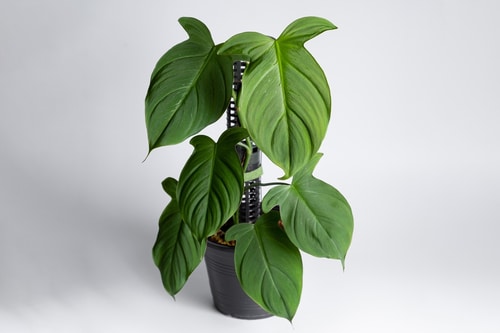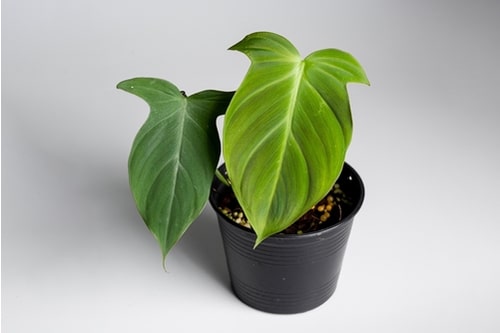The Philodendron Camposportoanum is a unique plant with attractive leaves that look pink when the sun’s rays hit the foliage. This variety of philodendron is relatively compact and is a non-climber.
Philodendron Camposportoanum is very easy to care for but requires slightly more water than other members of the Araceae family. Let’s look at how to grow and care for a Philodendron Camposportoanum plant.
What is a Philodendron Camposportoanum
The Philodendron Camposportoanum is a tropical plant that originates from the rainforests of Brazil and other tropical and sub-tropical regions of South America. These plants are part of the Araceae family, of which philodendrons make up a large part.
Philodendron Camposportoanum is a popular houseplant that’s unique and eye-catching. The leaves vary in shape. These plants commonly have pointed leaves with two lobes at the base. The shape of the foliage is referred to as “hammer leaves.” Another unique thing about this plant is the velvety texture of the leaves which is nice and soft.
The Philodendron Camposportoanum is a compact variety of philodendrons, which, unlike most varieties, doesn’t climb. These plants are the perfect houseplant as they won’t spread and take over your home. Most Philodendron Camposportoanum plants grow up to 1 and a half feet in height. The leaves are also relatively small and can grow up to 8 inches wide.
Like all varieties of philodendron, the Camposportoanum is toxic to humans and pets if ingested. It should be kept away from young children, cats, and dogs as these plants can prove to be fatal.
How to Care for a Philodendron Camposportoanum
The Philodendron Camposportoanum has many of the same care requirements as other varieties of philodendron. It’s recommended that you provide this plant with slightly more water. Here’s how to grow a thriving Philodendron Camposportoanum plant:
Sunlight Requirements
Philodendron Camposportoanum requires sunlight that’s bright and indirect. Tropical plants require enough light to thrive but can grow in dabbled shade. Be careful not to leave your plant in the full sun, or its leaves will be burned by the sun’s UV rays.
Too much sun will cause the plant’s leaves to turn yellow and brown patches will develop if the foliage been burnt. You can grow your plant under shade cloth or on an or east-facing windowsill to avoid sunburn.
Watering Requirements
The Philodendron Camposportoanum requires slightly more water than other varieties of Philodendron. You only need to check that the topsoil feels dry before watering rather than testing the first 2 inches of soil.
Aim to keep the soil moist, but be careful not to overwater your plant. Overwatering can lead to brown leaves and foliage dropping off, which are both symptoms of root rot. You’re your plant is unable to get the required oxygen and nutrients from the soil, it will suffer and may eventually die.
Soil
Philodendron Camposportoanum plants require s good quality soil that’s well-draining. Any excess water should be able to drain away to prevent root rot. Your plant will also need adequate aeration, so choosing loose soil is best.
It’s best to use a pot with drainage holes at the bottom and add a layer of stones, charcoal, or gravel at the bottom of the is to allow excess water to drain away if you accidentally overwater your plant.
Use porous soil that contains a mixture of perlite, peat moss, and sand for the Philodendron Camposportoanum. These soil ingredients will allow excess water to drain away and will also provide oxygen to your plant’s roots.
PH
The Philodendron Camposportoanum prefers neutral soil with a pH of 7. Bottom of FormIf you add sphagnum peat-moss to your soil, do so in small amounts as it’s highly acidic. You can also add some lime to the earth to help balance the pH range.
Temperature
Philodendron Camposportoanum thrives in warm temperatures of between 60F to 75F. They can cope with a slightly lower nighttime temperature of about 55F. Don’t leave your plant outside if frost is likely, as tropical plants aren’t resistant to frost.
Philodendrons can be grown outdoors in USDA Zones 9 to 11. If you live in a slightly cooler region, you can move your plant onto a patio for the summer. Ensure your plant is moved back indoors in the fall.
Humidity
Philodendron Camposportoanum like relatively high humidity as they are tropical plants. Aim for humidity of at least 50%. Your plant will survive in humidity that’s less than the rainforests, but it’s worth making an effort to provide some moisture for your plant.
An easy way to provide the correct humidity levels is to place your plant in the bathroom or kitchen. These rooms naturally have higher humidity than the rest of your home. Tropical plants benefit from the steam created when you have a shower.
Alternatively, you can use a tray with pebbles and water underneath your plant. This will help add moisture to the area surrounding your plant. If you have more than one tropical plant, grouping them together is also beneficial. You can use a fine spray bottle to mist your plants daily. Be careful not to soak the plant’s leaves, as this will encourage mold to grow.
Fertilizer
Slow-release fertilizers are best for the Philodendron Camposportoanum. Choose a good quality product that will ensure your plant gets the nutrients it requires. Nitrogen is vital for philodendrons, as it helps to create lush, green leaves. Slow-release products are often best as they will mean your plant is never under or over-fertilized. Alternatively, you can use a diluted liquid fertilizer once a month during the growing season. Your plant won’t require fertilizer in the winter.
Conclusion
Philodendron Camposportoanum is a unique plant that has lovely green leaves that look pink in the sunshine. They are easy to care for and make the perfect tropical plant for beginners. You’ll need to place your plant in bright indirect light, provide water regularly, use a well-draining soil mix and mist your plant daily to improve humidity.
Related: Philodendron Rojo Congo

